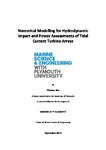Numerical Modelling for Hydrodynamic Impact and Power Assessments of Tidal Current Turbine Arrays
| dc.contributor.supervisor | Conley, Daniel C. | |
| dc.contributor.author | Roc, Thomas | |
| dc.contributor.other | School of Biological and Marine Sciences | en_US |
| dc.date.accessioned | 2013-07-08T10:58:26Z | |
| dc.date.available | 2013-07-08T10:58:26Z | |
| dc.date.issued | 2013 | |
| dc.date.issued | 2013 | |
| dc.identifier | 10210695 | en_US |
| dc.identifier.uri | http://hdl.handle.net/10026.1/1557 | |
| dc.description.abstract |
Channel constrictions in which strong currents are mainly driven by tidal processes represent sites with high potential for harvesting renewable and predictable tidal stream energy. Tidal Current Turbines (TCTs) deployed in arrays appear to be the most promising solution to efficiently capturing this carbon neutral energy resource. However to ensure the sustainable character of such projects, the balance between power extraction maximization and environmental impact minimization must be found so that device layout optimization takes into account environmental considerations. This is particularly appropriate since both resource and impact assessments go intrinsically hand in hand. The present method proposes the use and adaptation of ocean circulation models as an assessment tool framework for tidal current turbine (TCT) array-layout optimization. By adapting both momentum and turbulence transport equations of an existing model, the present TCT representation method is proposed to extend the actuator disc concept to 3-D large scale ocean circulation models. Through the reproduction of physical experiments to reasonable accuracy, grid and time dependency tests and an up-scaling exercise, this method has shown its numerical validity as well as its ability to simulate accurately both momentum and turbulent turbine-induced perturbations in the wake. These capabilities are demonstrated for standalone devices and device arrays, and are achieved with a relatively short period of computation time. Consequently the present TCT representation method is a very promising basis for the development of a TCT array layout optimization tool. By applying this TCT representation method to realistic cases, its capability is demonstrated for power capture assessment and prediction of hydrodynamic interactions as would be required during the layout deployment optimization process. Tidal energy has seen considerable development over the last decade and the first commercial deployments are likely to take place within the next 5 years. It is hoped that this new tool and the numerical approaches described herein will contribute to the development of TCT array power plants around the world. | en_US |
| dc.description.sponsorship | Great Western Research and International Power Marine Developments Limited | en_US |
| dc.language.iso | en | en_US |
| dc.publisher | University of Plymouth | en_US |
| dc.subject | Wake interactions | |
| dc.subject | Numerical modeling | |
| dc.subject | Regional Ocean Circulation Modelling System (ROMS) | |
| dc.subject | Tidal current turbine arrays | en_US |
| dc.title | Numerical Modelling for Hydrodynamic Impact and Power Assessments of Tidal Current Turbine Arrays | en_US |
| dc.type | Thesis | |
| plymouth.version | Full version | en_US |
| dc.identifier.doi | http://dx.doi.org/10.24382/3720 |
Files in this item
This item appears in the following Collection(s)
-
01 Research Theses Main Collection
Research Theses Main


